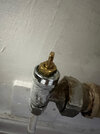Since we had a new boiler installed I am struggling to balance the radiators - they will be fine for a few days or even weeks but eventually go very tepid.
Because they are tepid It's difficult to work out which order they run in.
I have just brought some digital thermometer clips and plan on trying to get them all with a 12 degree diference but unsure which side I should adjust as on many radiators the screw looks the same - only one is usually covered with an old school +/- nob - I believe that is a manual valve and the lockshiled is the opposite side to that?
I thought the lock shield was the outlet and would be the cooler side, but on some radiators this seems to fill the radiator and is generally hotter!
So confused becasue all the YouTube videos are based on rads with thermostatic valves and we have none!
Because they are tepid It's difficult to work out which order they run in.
I have just brought some digital thermometer clips and plan on trying to get them all with a 12 degree diference but unsure which side I should adjust as on many radiators the screw looks the same - only one is usually covered with an old school +/- nob - I believe that is a manual valve and the lockshiled is the opposite side to that?
I thought the lock shield was the outlet and would be the cooler side, but on some radiators this seems to fill the radiator and is generally hotter!
So confused becasue all the YouTube videos are based on rads with thermostatic valves and we have none!




